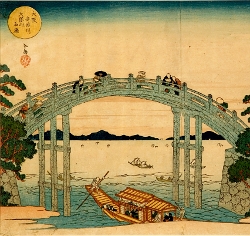Japan emerged from 250 years of self-imposed isolation as a dazzling light of inspiration. Fascination with the art of Japan grew rapidly in the late 19th century and greatly influenced art and style in the West. Japanese compositional and formal characteristics in fact played a central role in the development of modern Western art. Like Europeans of the period, American designers produced Japanese-inspired decorative objects of all kinds. This vignette might be a contemporary room of someone who is much taken with that moment around 1900 when Japanese concepts of form, color, texture, and space were new and very fashionable. In this room—surrounded by Japanese objects and Western objects reflecting in some way the art of Japan—one might pay homage to traditional Japanese ritual by sharing a cup of tea.
The heavy lead lines and floral design of the Hollyhocks leaded-glass window, c. 1881, by John La Farge (1835–1910) were much influenced by ukiyo-e (pictures of the floating world) woodblock prints such as those on view here by Andō Hiroshige (1797–1858) and Katsushika Hokusai (1760–1849). Other Japanese objects include tsuba (sword guards) from the middle Edo period (1603–1867) and 19th century carved ivory netsuke, fasteners that allowed men to carry pouches or boxes on their kimono sashes. Japanese motifs such as fish, birds, and dragonflies, found their way into all manner of Western decorative art, including here the Dragonfly & Water lampshades, c. 1910, from Tiffany Studios. Ceramics by Rookwood Pottery and the influential British designer Christopher Dresser (1834–1904) further enhance the room’s theme.



